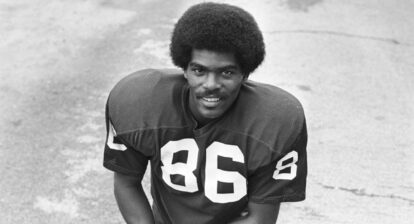OPINION: The documentary about the life, success and struggles of legendary vocalist Luther Vandross is a must-watch.
Editor’s note: The following article is an op-ed, and the views expressed are the author’s own. Read more opinions on theGrio.
It is so easy to take musical greatness for granted. I suppose it’s easy to do with any level of greatness, really; but there’s something about the emotional resonance of music that gets into your soul. When you grow up witnessing people consistently do things that seem otherworldly, it’s easy to assume those gifts and those people will always be there providing that entertainment or comfort.
I think Luther Vandross is an artist I took for granted, and watching the documentary about his life and career, “Luther: Never Too Much,” reminded me that I need to stop doing that. Over almost an hour and forty minutes, we’re treated to Luther’s life story told through his words and the words of those who were there, living and creating right beside him. In the process, I was also reminded that Luther Vandross was literally the soundtrack to my upbringing. I cannot remember a time when Luther wasn’t part of my life. Luther was basically every Saturday morning in my house, as I imagine most other Black households in the 1980s and 1990s.
When my dad woke up on Saturdays and started playing music, maybe all of it wasn’t Luther, but Luther (any Luther) was definitely part of the musical offerings. I got misty-eyed several times during the documentary as they traversed his career’s beginnings, but especially when they got to his first solo album, “Never Too Much,” because though I was only two when the album was released, it might be the song I’ve heard the most over the 45 years of my life to date. Watching the segment where the musicians were introduced to the song via Luther and then watching him sing it reignited something from my childhood; it took me right back to the house I lived in in Bad Homburg, Germany. Clear as day, I could see my living room and my parents’ sound system with the record spinning, and couldn’t help tearing up.
I could see the album cover sitting on the floor, leaning against the shelf, while the songs played. Obviously, I don’t remember this as a two-year-old, but as a five- or six-year-old? Absolutely. Luther’s definitive version of “A House Is Not A Home,” featured on that same album, has been a constant in my life for as long as I can remember. I don’t know a person who doesn’t know his version like the back of their hand; it is essential Black listening. As Jamie Foxx said in the film, this cat made singing about furniture sound sexy and amazing.
Straight up, if Luther had ONLY sung those two songs ever, he still might be a household name in Black America. But he didn’t — Luther gave us so many songs and so many hits and so much feeling and soul; I honestly can’t imagine my life without him. I know this because I have introduced my kids to Luther — on the car rides to and from school, you’d better believe that Luther, and I mean ANY Luther, plays between “They Not Like Us” and whatever songs are popular on TikTok at the moment. Luther is essential to my life.
I was also reminded of all of the moments of his life that became points of debate amongst my friends and the larger Black community. For instance, I felt guilty for the conversations we used to have about “Skinny Luther” versus “Fat Luther,” a topic that made its way into Black pop cultural conversations for years. Seeing how his weight losses and gains affected him broke my heart. I always knew that was the case, but seeing how he was so negatively impacted by those public conversations made me cringe at all of the times I made a joke about Luther’s weight.
I also remember having conversations about whether Luther Vandross is “Black-famous” or not — in other words, the concept that a person could be hugely famous in the Black community but not universally recognized in mainstream pop culture. Luther apparently recognized the racism at play in terms of budgets and promotions and marketing for his albums, and the industry’s reluctance to allow him to “cross over” to a broader audience. A part of me thinks Luther had too much soul to be truly appreciated by white America, but that also means Luther, who did very well financially, probably could have been doing even better if the record companies worked his records not just on Black radio, but pop radio stations. In 2025 (wow), I’m happy that I know I will hear his records whenever I turn on the radio, most especially in “Quiet Storm” formats, but understandably, Luther wanted full recognition for his talents. Watching the documentary, I was frustrated that he felt he didn’t get his just due as a singer, songwriter, producer, arranger and composer. I know we love us some Luther — and I hope he knew that — but I also understand, as an artist, feeling pigeonholed by forces outside of your own control.
That frustration was evident in Luther’s quest for a Grammy Award — a frustration he openly shared amongst his collaborators and friends. He didn’t win one until 1991, eight years after embarking on his solo career, and after nine nominations — he finally won Best Male R&B Vocal Performance Grammy for “Here and Now.” Honestly, Best Male R&B Vocal Performance could be named after Luther and not a single soul would bat an eye.
However, what I found most emotional was the end of Luther’s life. I don’t even know why; he has been gone for over twenty years now. But Luther is an artist who has been vital to my experience as a Black person in America; watching his struggles through my adult eyes hits different. Luther was only 54 years old when he passed — and that is too young. We’ve lost so many great entertainers at ages that used to sound old but now feel criminally premature. I suppose I so was caught up in this supremely well-told story about his life through snippets and interviews and pictures I’ve never seen before, it was like losing Luther all over again in real-time. I was 21 when he passed away; now I’m 45 and have newfound appreciation and reverence for artists I, again, probably took for granted. I miss Luther Vandross — I guess that’s the best way to put it. Even with a cemented musical legacy as one of the greats, I mourn what was left on the table.
“Luther: Never Too Much” is a must-watch. I, surprisingly, shed so many tears reminiscing about a life lived with Luther Vandross as its soundtrack. It is a documentary that feels longer than its run time, and I mean that as a compliment. You never realize how much an artist means to you until you’re looking at their life laid out before you and can see the moments they impacted you personally. That was me for the entirety of the documentary. Luther has been a part of so many joyful moments in my life and will be until my life comes to an end. Luther’s “So Amazing,” is still one of my favorite songs ever; it stands as both a review and a compliment to the musical legacy of Luther Vandross.
I’m surprised it took this long to get a proper retrospective done on his life, but I’m thankful that it exists.
“Luther: Never Too Much” is now available on CNN related streamers and other select streaming apps.

Panama Jackson is a columnist at theGrio and host of the award-winning podcast, “Dear Culture” on theGrio Black Podcast Network. He writes very Black things, drinks very brown liquors, and is pretty fly for a light guy. His biggest accomplishment to date coincides with his Blackest accomplishment to date in that he received a phone call from Oprah Winfrey after she read one of his pieces (biggest) but he didn’t answer the phone because the caller ID said “Unknown” (Blackest).
More must-reads:






